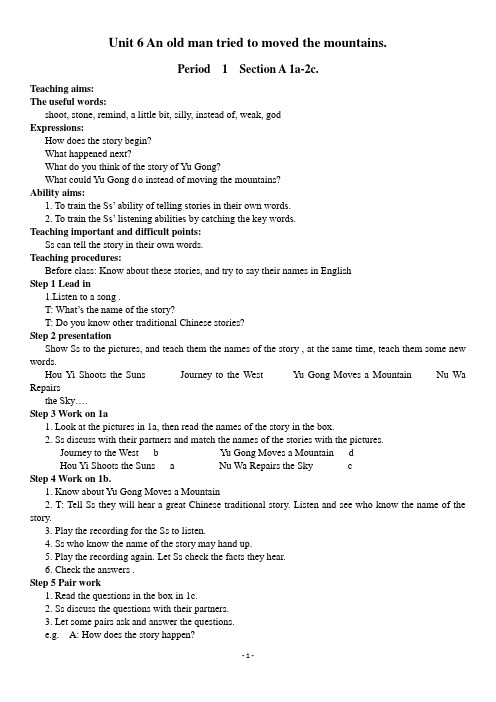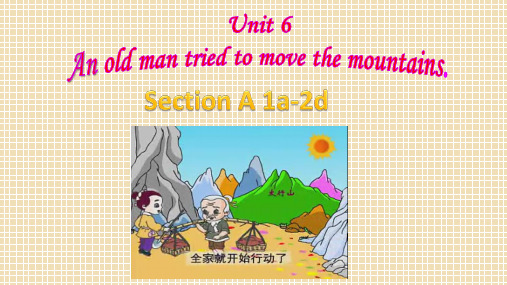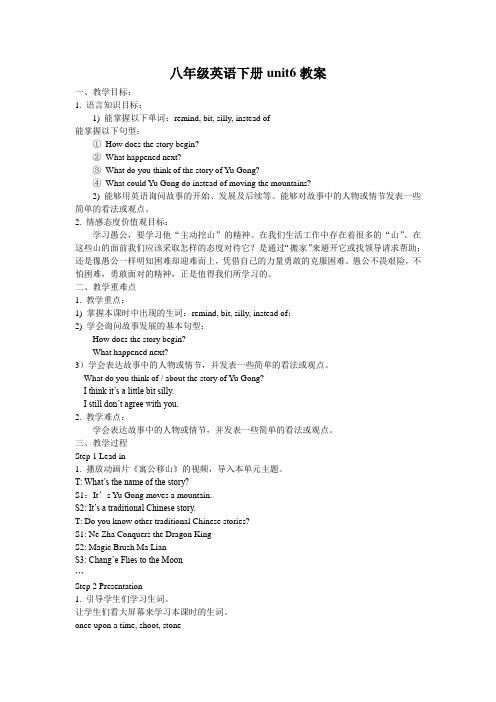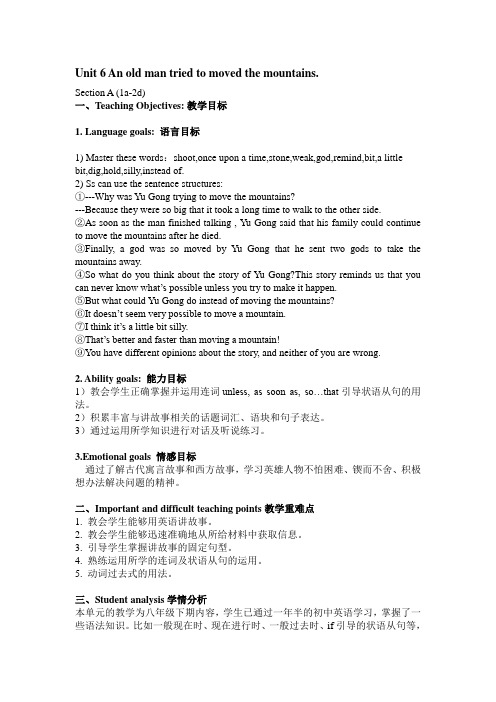优品课件之2018届八年级英语下册unit6教案(新版人教版)
- 格式:docx
- 大小:22.40 KB
- 文档页数:4

Unit 6 An old man tried to moved the mountains.Period 1 Section A 1a-2c.Teaching aims:The useful words:shoot, stone, remind, a little bit, silly, instead of, weak, godExpressions:How does the story begin?What happened next?What do you think of the story of Yu Gong?What could Yu Gong d o instead of moving the mountains?Ability aims:1. To train the Ss’ ability of telling stories in their own words.2. To train the Ss’ listening abilities by catching the key words.Teaching important and difficult points:Ss can tell the story in their own words.Teaching procedures:Before class: Know about these stories, and try to say their names in EnglishStep 1 Lead in1.Listen to a song .T: What’s the name of the story?T: Do you know other traditional Chinese stories?Step 2 presentationShow Ss to the pictures, and teach them the names of the story , at the same time, teach them some new words.Hou Yi Shoots the Suns Journey to the West Yu Gong Moves a Mountain Nu Wa Repairsth e Sky….Step 3 Work on 1a1. Look at the pictures in 1a, then read the names of the story in the box.2. Ss discuss with their partners and match the names of the stories with the pictures.Journey to the West b Yu Gong Moves a Mountain dHou Yi Shoots the Suns a Nu Wa Repairs the Sky cStep 4 Work on 1b.1. Know about Yu Gong Moves a Mountain2. T: Tell Ss they will hear a great Chinese traditional story. Listen and see who know the name of the story.3. Play the recording for the Ss to listen.4. Ss who know the name of the story may hand up.5. Play the recording again. Let Ss check the facts they hear.6. Check the answers .Step 5 Pair work1. Read the questions in the box in 1c.2. Ss discuss the questions with their partners.3. Let some pairs ask and answer the questions.e.g. A: How does the story happen?- 1 -B: There were two very tall mountains in front of their house.A: What happened next?B: A very old man tried to move the mountains.A: Where would they put all the earth and stone from the mountains?B: They would put them into the sea.Step 6 Work on 2a and 2bWork on 2a:T: Let’s continue to listen to the story.1. Look at the pictures in 2a. Discuss the things they are going to do. When you listen to the story, pleasenumber the pictures.2. Play the recording for the Ss to listen and number the pictures.3. Play the recording again to check the answers.Work on 2b:1. Let Ss read the sentences below. Explain some main sentences for the Ss. Make sure they know what to do.2. Play the recording for the Ss to circle the correct words in the brackets.3. Play the recording again to check the answers.Answers: 1. children 2. weak 3. talking 4. two 5. knowStep 7 Pair work1. Tell Ss to make a story chain. Ss tell the story one by one with the pictures in 2a.2. Let some Ss tell the story to the class.3. See which groups’ story is better.Step 8 Homework:Tell the story Yu Gong Moves a Mountain in English to your parents.Once upon a time, there was a very old man…Period 2 Section A 2d GrammarTeaching aims:The useful words:stepsister, prince, couple, smile, marry , get married, fit, fall in love; unless, as soon as, so…that Expressions:Because they were so big that it took a long time to walk to the other side.Unless he can hide his tail, he can’t turn himself into a person.As soon as the man finished talking , Yu Gong said that his family could continue to move the mountains after he died.Ability aims:1. To train the Ss’ ability of telling stories in their own words.2. To understand “unless; so…that…; as soon as…”.Teaching important and difficult points:1. To train the Ss’ ability of telling stories in their own wor ds.2. To understand “unless; so…that…; as soon as…”.Teaching procedures:Step 1 Revision Review the story of Yugong.Step 2 Role-play1. Read the conversations and answer the questions.○1What does Wang Ming think about the story of Yu Gong?○2What about Claudia’s opinion?○3What way can Yu Gong use according to Claudia?○4Do they agree with each other at last ?○5What’s the teacher’s opinion?2. Ask Ss to role-play the conversation in groups.Step 3 Grammar focus1. Read Grammar Focus.2. Understand unless; as soon as; so ... thatStep 4 New wordsLook at the big screen and learn the new words and expressions:stepsister ; prince ; fit ; couple; smile ; marry ; fall in loveStep 5 Work on 4a:1. Tell Ss to read the sentences in 4a and try to fill in the blanks with unless, as soon as, so…that.2. chech the answers.Step 6 Work on 4b:1. Tell Ss to read the sentences in 4a and try to fill in the blanks2. Check the answers with the Ss.Step 7 Telling storiesStep 8 Homework1. Recite the conversation in 2d after school.Period 3 Section A (3a-3c)Teaching aims:The useful words:object, magic, stick, hide, ta il, turn…into, excite, western ;turn intoExpressions:The Monkey King is not just any normal monkey.Ability aims:1. To train the Ss’ ability of reading.2. To understand the sentences like “But unless he can hide his tail, he cannot turn himselfinto a person. ”Teaching important and difficult points:1. To train the Ss’ ability of reading.2. To understand the sentences like “But unless he can hide his tail, he cannot turn himselfinto a person. ”Teaching procedures:Step 1 Warm up and lean-in.1. Listen to a song.2. Look at the pictures and answer the questions.Which book is talked about? Journey to the West;Who is the main character? Monkey King best.3. Watch a video about the Monkey King and introduce the Monkey King..- 3 -Step 2 While reading .1. Read the article quickly and match the main ideas.2. Work on 3b:What he can do:① He can make 72 changes to his shape and size, turning himself into different animals and objects② He can make his magic stick small or large.What he can’t do:Unless he can hide his tail, he can’t turn himself into a person.3. Work on 3cStep3 HomeworkMake sentences with these wor ds.be able to; make 72 changes, turn…into; so…that; came out; become interested in;keep doing sth.Period 4 Section B 1a---1dKnowledge aims:1.Get the students to learn the words and phrases:gold, emperor, silk, underwear, nobody, stupid, cheat2.Learn and know the sentences below:1).Once upon a time, there was an emperor…2).People couldn’t see the clothes unless they were clever.3).Nobody wanted to sound stupid, so everyone said his new clothes were wonderful.3. Learn to tell a story in English.4. Let students have a chance to know the difference between Chinese culture and foreignculture.Ability aims:1、To train students’ listening and speaking skills2、Listening to get the general idea and the detailed information.3. Speaking to practice oral English.Emotional aims:Remember to dare to say the truth. We should be honestKey points:1.Learn and know how to spell and use the new words in the text.2. Listening practice. Train ing students’ listening skill and the ability to catch keyinformation.3. Rewrite The Emperor’s New Clothes.Difficult points:1.Listening practice.2. Rewrite The Emperor’s New Clothes.Teaching procedure:Step 1 Warm up1. Pair-workWe have known a few Chinese traditional stories, which story do you like best? Please tellyour partner about your favorite story.T: Show one picture of the story The Emperor’s New Clothes.2. Ask some questions about it.1). Look at the picture. Do you know this story?What’s the name of this story?S1: The Emperor’s New Clothes.2). Can you tell the story briefly?Show a cartoon ab out The Emperor’s New Clothes to students so that they can understandthe story better.Step 2 Presentation1.Present the new words on the big screen and learn the new words together.2. Ss read and try to remember the new words.silk emperor underwear gold stupid cheat3. Matching (1a)1). Ask one student read words in 1a. Tell Ss to match the words with the letters in the pictures in 1b.2). Let some Ss tell their answers. Then check together.3). Try to remember the new words.Step 3 Practice (Listening)1.Work on 1b1). Tell Ss to look at the pictures in 1c. Tell them these are the pictures from the story: The Emperor’sNew Clothes. Listen to the tapes and number the pictures.2). Play the recording for the Ss just one time, and ask students to number the pictures.3). Check the answers:2.Work on 1c:1). Let Ss read the sentences in 1c first. Tell Ss to listen again and fill in the blanks with the rightwords.2). Play the recording again for the Ss to listen and write the words.3). Check the answers with the class.Keys: clothes, brothers, give, kept, looked, saw, shouted, wearingStep4 ProductionExercise: Read the listening material and try to answer the questions?1. What’s the name of the story?2. Is it a traditional Chinese story?3. What’s the emperor’s hobby?4. Why were the new clothes special?5. How do we know that the two brothers were really trying to cheat the emperor?6. Why didn’t every one say that the new clothes were really nice?7. Who said that the emperor wasn’t wearing any clothes?Keys: 1. It’s The Emperor’s New Clothes.2. No, it isn’t. It’s from Europe.3. He liked new clothes. He loved buying and looking at his new clothes.4. Because people couldn’t see the new clothes unless they were clever.5. Because they kept all the gold and silk for themselves.6. Because they didn’t want other people to know that they were stupid.7. A young boy.Step 5 Rewrite the story- 5 -1. Rewrite the story of The Emperor’s New Clothes. Use the information in 1c and 1d.2. Let some students tell the story to the class.Step6 HomeworkTry to write an ending on the basis of The Emperor’s New Clothes.Period 5 Section B 2a-3bKnowledge aims:1.Words:stepmother, wife , husband, whole, scene, stone, shine, ground , lead, voice, inside, bravea fairy tale, inside the house, the rest of , make a plan, get wood, come back, never mind, inthe forest2. Sentences :One year, the weather was so dry that no food would grow.Unless we do , we won’t find our way out.When the moon is shini ng bright, we’ll be able to see the stones.As soon as the moon rises, we can follow them instead.Ability aims:1. Ss can make and talk about predictions2. Ss can summarize key parts of a story3. Ss can understand the whole article and rewrite the play.Emotional aims:Whatever you do Wherever you go ,Be independent and never give up!Teaching key points:1. To learn about the western fairy play, read and understand the whole play ,then try toperform2. To develop their reading skills such as skimming, scanning,summarizing language pointsTeaching difficult points:(1) It is the first time for students to read the text type –play. Understand the form of westernfairy tales and perform the play.(2) To acquaint Ss with the moral messages it contains.(3) Develop the ability of skimming and scanning.Teaching procedure:Step1 Warm-up and lead in .1.T: A fairy tale is an old ,traditional story.In this unit we have learned some fairy tales. Lookat the pictures, do you know these fairy tales?Tell Ss their English names and lead in reading aloud.2. Introduce the three fairy tales.3.Then tell them: Today we will continuelearning another fairy tale ---Hansel and Gretel.Step2 before reading.1. Look quickly through this text, answer the questions.2. How do you know that?3. Watch the video and answer the following questionsHow many members are there in the family? Who are they?Step 3 While reading.1.Read the first paragraph of Hansel and Gretel. Think about how the fairy tale willcontinue. Then read the rest of the story.2. Work on 2c.T: Now let’s read the play carefu lly and try to match each description below with the correct scene.Ss read the play quickly and try to match each description.3. Work on 2d Careful reading.Read the passage carefully and answer the following questions:Why does the wife tell her husband to leave the children in the forest?What does Hansel go out to get?Why does he do this in the moonlight?How do Hansel and Gretel find their way home?Why do Hansel and Gretel get lost the second time?4.At the same time write the key words from each scene and give the summary. Step 5 After reading.1.Guess what will happen and give the play an ending.Do you think they are in danger, why?What would happen when the old woman came out of the house?What will the brave children do?2. What do you think of Hansel and Gretel ?What can we learn form the fairy tale ?Step 6 Summarize and homework.- 7 -。



八年级英语下册unit6教案一、教学目标:1. 语言知识目标:1) 能掌握以下单词:remind, bit, silly, instead of能掌握以下句型:①How does the story begin?②What happened next?③What do you think of the story of Yu Gong?④What could Yu Gong do instead of moving the mountains?2) 能够用英语询问故事的开始、发展及后续等。
能够对故事中的人物或情节发表一些简单的看法或观点。
2. 情感态度价值观目标:学习愚公,要学习他“主动挖山”的精神。
在我们生活工作中存在着很多的“山”。
在这些山的面前我们应该采取怎样的态度对待它?是通过“搬家”来避开它或找领导请求帮助;还是像愚公一样明知困难却迎难而上,凭借自己的力量勇敢的克服困难。
愚公不畏艰险,不怕困难,勇敢面对的精神,正是值得我们所学习的。
二、教学重难点1. 教学重点:1) 掌握本课时中出现的生词:remind, bit, silly, instead of;2) 学会询问故事发展的基本句型:How does the story begin?What happened next?3)学会表达故事中的人物或情节,并发表一些简单的看法或观点。
What do you think of / about the story of Yu Gong?I think it’s a little bit silly.I still don’t agree with you.2. 教学难点:学会表达故事中的人物或情节,并发表一些简单的看法或观点。
三、教学过程Step 1 Lead in1. 播放动画片《寓公移山》的视频,导入本单元主题。
T: What’s the name of the story?S1:It’s Yu Gong moves a mountain.S2: It’s a traditional Chinese story.T: Do you know other traditional Chinese stories?S1: Ne Zha Conquers the Dragon KingS2: Magic Brush Ma LianS3: Chang’e Flies to the Moon…Step 2 Presentation1. 引导学生们学习生词。

Unit 6 An old man tried to moved the mountains.Section A (1a-2d)一、Teaching Objectives: 教学目标1. Language goals: 语言目标1) Master these words:shoot,once upon a time,stone,weak,god,remind,bit,a little bit,dig,hold,silly,instead of.2) Ss can use the sentence structures:①---Why was Yu Gong trying to move the mountains?---Because they were so big that it took a long time to walk to the other side.②As soon as the man finished talking , Yu Gong said that his family could continue to move the mountains after he died.③Finally, a god was so moved by Yu Gong that he sent two gods to take the mountains away.④So what do you think about the story of Yu Gong?This story reminds us that you can never know what’s possible unless you try to make it happen.⑤But what could Yu Gong do instead of moving the mountains?⑥It doesn’t seem very possible to move a mountain.⑦I think it’s a little bit silly.⑧That’s better and faster than moving a mountain!⑨You have different opinions about the story, and neither of you are wrong.2. Ability goals: 能力目标1)教会学生正确掌握并运用连词unless, as soon as, so…that引导状语从句的用法。

新人教版八年级英语下册Unit6(1)教案
教学目标
1. 通过本课的研究,学生能够掌握有关地理位置的词汇和句型。
2. 学生能够理解并运用英语描述地理位置。
3. 学生能够在实际情境中运用所学内容进行交流和表达。
教学重点
1. 掌握地理位置的词汇和句型。
2. 能够准确理解并描述地理位置。
3. 能够运用所学内容进行实际情境交流和表达。
教学内容及安排
1. 导入(5分钟)
- 利用图片或地图提问,引导学生回忆和讨论有关地理位置的
词汇。
- 引入本课要研究的句型:“Where is...?”和“...is in/on/near...”。
2. 研究和练(30分钟)
- 分发课本,让学生跟读和标注关键词汇。
- 运用图片或地图激发学生对不同地理位置的描述,引导学生
进行口头练。
- 利用小组活动或角色扮演的方式,让学生自主练和运用所学
句型。
3. 拓展应用(15分钟)
- 设计小组任务,要求学生分析并描述实际情境中的地理位置。
- 引导学生用英语进行小组讨论和报告,展示他们的成果。
4. 总结和评价(10分钟)
- 强调本课所学的地理位置句型和词汇的重要性。
- 鼓励学生在日常生活中积极运用所学内容。
- 对学生的表现给予积极评价和反馈。
教学资源
- 标有地理位置的图片或地图
- 教材《新人教版八年级英语下册》
教学评价方式
- 学生口头表达的准确性和流利度
- 小组讨论和报告的效果和内容
参考资料
无。
Unit 6 An old man tried to move the mountains.第一课时Section A (1a2d)【学习目标】1.重点单词:shoot,begin,god,remind,bit,silly2.重点短语:Journey to the West,Yu Gong Moves a Mountain,Hou Yi shoots the Suns,Nu Wa Repairs the Sky,once upon a time,instead of,work on,a little bit3.重点句式:An old man tried to move the mountains.How does the story begin?Where would they put all the earth and stone from the mountains?As soon as the man finished talking,Yu Gong said that his family could continue to move the mountains after he died.Finally,a god was so moved by Yu Gong that he sent two gods to take the mountains away.It doesn't seem very possible to move a mountain.The story is trying to show us that anything is possible if you work hard.Yu Gong kept trying and didn't give up.I think we should try to find other ways to solve a problem.What could Yu Gong do instead of moving the mountains?That's better and faster than moving a mountain!You have different opinions about the story,and neither of you are wrong.There are many sides to a story and many ways to understand it.【学习重点】1.重点短语和句型2.unless,so...that,as soon as...等的用法【学习难点】1.重点短语和句型2.unless,so...that,as soon as...等的用法【自学学习】一、预习课本P4142新单词并背诵,完成下面的汉译英。
2018届八年级英语下册unit6教案(新版人教版)Unit 6 An old man tried to moved the mountains. Section A 1 (1a-2d) 一、教学目标: 1. 语言知识目标:1) 能掌握以下单词:remind, bit, silly, instead of 能掌握以下句型:① How does the story begin? ② What happened next? ③ What do you think of the story of Yu Gong? ④ What could Yu Gong do instead of moving the mountains? 2) 能够用英语询问故事的开始、发展及后续等。
能够对故事中的人物或情节发表一些简单的看法或观点。
2. 情感态度价值观目标:学习愚公,要学习他“主动挖山”的精神。
在我们生活工作中存在着很多的“山”。
在这些山的面前我们应该采取怎样的态度对待它?是通过“搬家”来避开它或找领导请求帮助;还是像愚公一样明知困难却迎难而上,凭借自己的力量勇敢的克服困难。
愚公不畏艰险,不怕困难,勇敢面对的精神,正是值得我们所学习的。
二、教学重难点 1. 教学重点: 1) 掌握本课时中出现的生词:remind, bit, silly, instead of; 2) 学会询问故事发展的基本句型:How does the story begin? What happened next? 3)学会表达故事中的人物或情节,并发表一些简单的看法或观点。
What do you think of / about the story of Yu Gong? I think it’s a little bit silly. I still don’t agree with you. 2. 教学难点:学会表达故事中的人物或情节,并发表一些简单的看法或观点。
三、教学过程 Step 1 Lead in 1. 播放动画片《寓公移山》的视频,导入本单元主题。
T: What’s the name of the story? S1:It’s Yu Gong moves a mountain. S2: It’s a traditional Chinese story. T: Do you know other traditional Chinese stories? S1: Ne Zha Conquers the Dragon King S2: Magic Brush Ma Lian S3: Chang’e Flies to the Moon … Step 2 Presentation 1. 引导学生们学习生词。
让学生们看大屏幕来学习本课时的生词。
once upon a time, shoot, stone 2. Try to remember the new words. Step 3 Writing 1. Look at the pictures in 1a, then read the names of the story in the box. 2. Ss discuss with their partners and match the names of the stories with thepictures. Journey to the West b Yu Gong Moves a Mountain d Hou Yi Shoots the Suns a Nu Wa Repairs the Sky c Step 4 Listening 1. T: Tell Ss they will hear a great Chinese traditional story. Listen and see who know the name of the story. 2. Play the recording for the Ss to listen. 3. Ss who know the name of the story may hand up. 4. Play the recording again. Let Ss check the facts they hear. 5. Check the answers. ____ The two mountains were very high and big. ____ A very old man tried to move the mountains. ____ A man told Yu Gong that he could never do it.Step 5 Pair work 1. Read the questions in the box in 1c. 2. Ss discuss the questions with their partners. 3. Let some pairs ask and answer the questions. e.g. A: How does the story happen? B: There were two very tall mountains in front of their house. A: What happened next? B: A very old man tried to move the mountains. A: Where would they put all the earth and stone from the mountains? B: They would put them into the sea. Step 6 Listening Work on 2a: T: Let’s continue to listen to the story. 1. Look at the pictures in 2a. Discuss the things they are going to do. When you listen to the story, please number the pictures. 2. Play the recording for the Ss to listen and number the pictures. 3. Play the recording again to check the answers. Work on 2b: 1. Let Ss read the sentences below. Explain some main sentences for the Ss. Make sure they know what to do. 2. Play the recording for the Ss to circle the correct words in the brackets. 1) A man saw Yu Gong and his (children / family) when they were working on moving the mountains. 2) He told Yu Gong he could never do it because he was old and (poor / weak). 3) As soon as the man finished (talking /speaking), Yu Gong said that his family could continue to move the mountains after he died. 4) Finally, a godwas so moved by Yu Gong that he sent (two / three) gods to take the mountains away. 5) This story reminds us that you can never (know / see) what’s possible unless you try to make it happen. 3. Play the recording again to check the answers. Answers: 1. children 2. weak 3. talking 4. two 5. know Step 7 Pair work 1. Tell Ss to make a story chain. Ss tell the story one by one with the pictures in 2a. 2. Let some Ss tell the story to the class. 3. See which groups’ story is better. Step 8 Role-play 1. Read the conversations and Let Ss read after the teacher. 2. Ask Ss to role-play the conversation in groups. Some main points: (1) 1. This story reminds us that you can never know what’s possible unless you try to make it happen. remind v. 提醒;使想起 remind sb. of/about sth. 提醒某人想起某事 e.g. The picture reminds him of his beautiful hometown. 这幅画让他想起了美丽的故乡。
remind sb. to do sth. 提醒某人去做某事 e.g. Please remind me to come back early. 请提醒我早点回来。
【运用】根据汉语意思补全下列英语句子,每空一词。
① 这个故事让我想起了我的童年。
This story ________ _____ ______ my childhood. ② 今天晚上你能提醒我给汤姆打电话吗? Couldyou please ________ ________ ____ _____ Tom up tonight? (2) I think it’s a little bit silly. bit n. 有点;稍微 a little bit (= a little) + 形容词或副词或比较级时,表示“一点儿” e.g. I’m a little bit tired. Let’s take a short rest. 我有点累了,让我们休息一会。